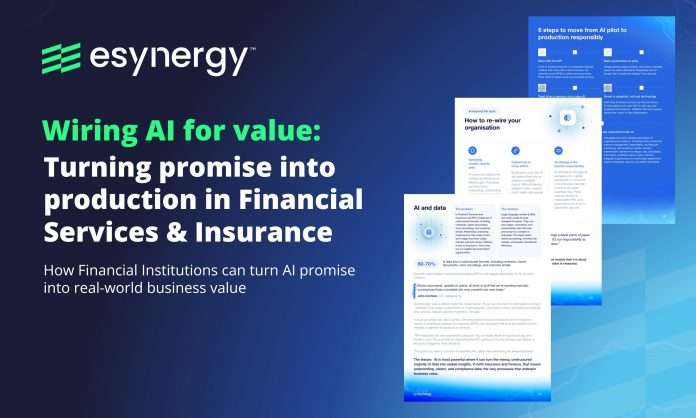Artificial intelligence (AI) has moved from hype to boardroom priority in financial services and insurance, but the challenge now lies in translating potential into measurable business value.
A new whitepaper from esynergy, ‘Wiring AI for Value: Turning Promise into Production in Financial Services and Insurance’, explores how firms can bridge this gap—shifting from experiments and pilots to fully integrated, governed AI operations. Drawing on insights from eight senior technology leaders across the industry, the paper highlights the practical steps institutions can take to realise AI’s promise while maintaining trust, compliance, and cost efficiency.
For many organisations, the first step is acknowledging that AI is not simply a technology project—it’s a business strategy. According to the paper, institutions must approach AI deployment with the same level of governance and cross-functional coordination as any other enterprise-wide initiative. That means ensuring leadership alignment, embedding transparency, and integrating AI literacy across all levels of the organisation.
Setting the scene for the whitepaper, esynergy head of AI Prasad Prabhakaran said, “While it may feel like artificial intelligence (AI) is something new, it has actually been an integral part of life for Financial Services and Insurance companies for decades, used to formulate credit risk models, anti-money laundering systems, pricing engines and churn prediction. Governed via model risk management (MRM), these initiatives have been at the very core of business. The recent advent of frontier large language models (LLMs) – such as ChatGPT – has caused considerable excitement, and rightly so: LLMs have the potential to be able to transform and illuminate entire workflows, from back and middle office to legal, compliance and customer services, areas that have – until now – been constrained by their reliance on unstructured data.”
Prabhakaran explained that while generative AI offers major advantages in efficiency, insight, and engagement, it also carries significant risks. “LLM’s output is probabilistic: they need to be explained, observed, and tested to ensure regulatory compliance. Lastly, Generative AI is a token economy, and consumption can quickly make AI operational expenditure unsustainable,” he said. To manage this, he advises firms to focus on context engineering, predictable cost structures, and full transparency in AI outcomes.
The whitepaper outlines how financial institutions can move from fragmented, siloed projects to enterprise-wide, production-ready AI. It identifies five leading use cases currently reshaping insurance and financial services. It also guides readers on how they can ‘rewire’ their organisation to adopt AI effectively, from leadership alignment and governance to AI literacy and adoption at scale.
However, regulatory caution remains a defining feature of AI adoption in the sector. As banks and insurers grapple with strict data-sharing limits and accountability requirements, many are developing proprietary large language models to maintain control over sensitive information. Gallagher Re CIO John Crichton said, “We cut off access to ChatGPT from company laptops because there’s a fear people will start using it for everything without review. Instead, we have our own AI engine, based on the same underlying technology, but we control it. Context and ring-fencing matter.”
Others, like Flagstone CTO Lee Provoost, emphasised the importance of internal education and governance. “You need to educate people that they can’t just copy and paste company IP into various tools. You need to provide vetted tools, because—guaranteed—people will be experimenting, and if you don’t control it, you risk leakage of intellectual property and sensitive client data.”
The consensus across contributors is clear: AI’s success in financial services depends on strong foundations—governance, transparency, and trust. Regulators will not accept “the algorithm made me do it” as an excuse, meaning firms must be accountable for every AI-driven decision. But for those that get it right, the rewards are transformative. Agentic AI systems can now automate discrete, high-impact tasks—such as validating quotes or extracting key details from underwriting data—freeing professionals to focus on strategic, high-value work.
Ultimately, Wiring AI for Value argues that AI in financial services has reached a turning point. The opportunity to redefine customer service, operational efficiency, and decision-making is enormous—but only if firms build the right “wiring” to support it. As the paper notes, success lies not in chasing hype, but in building robust, explainable, and sustainable AI systems that deliver long-term business value.
For more insights into generating real value from AI, read the full whitepaper here.
Read the daily FinTech news
Copyright © 2025 FinTech Global










